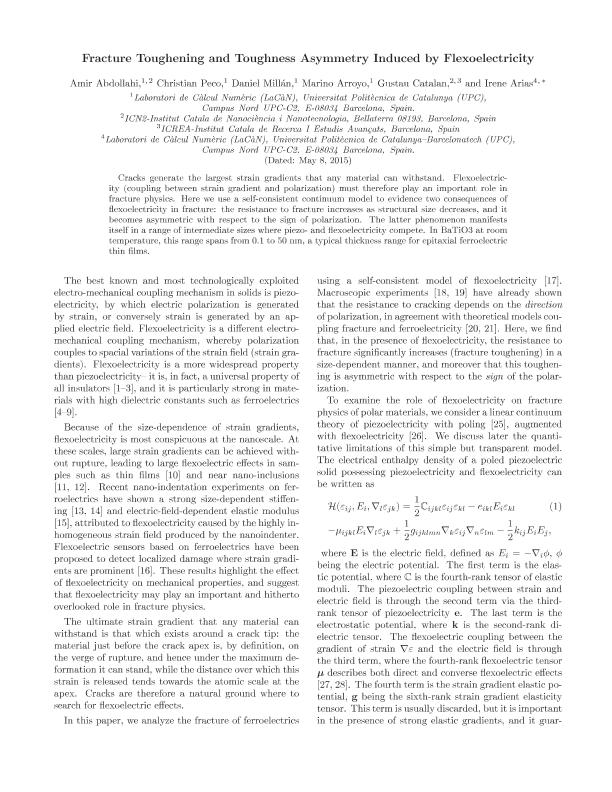Artículo
Fracture toughening and toughness asymmetry induced by flexoelectricity
Abdollahi, Amir; Peco Regales, Christian; Millán, Raúl Daniel ; Arroyo Balaguer, Marino; Catalan, Gustau; Arias, Irene
; Arroyo Balaguer, Marino; Catalan, Gustau; Arias, Irene
 ; Arroyo Balaguer, Marino; Catalan, Gustau; Arias, Irene
; Arroyo Balaguer, Marino; Catalan, Gustau; Arias, Irene
Fecha de publicación:
09/2015
Editorial:
American Physical Society
Revista:
Physical Review B: Condensed Matter and Materials Physics
ISSN:
1098-0121
Idioma:
Inglés
Tipo de recurso:
Artículo publicado
Clasificación temática:
Resumen
Cracks generate the largest strain gradients that any material can withstand. Flexoelectricity (coupling between strain gradient and polarization) must therefore play an important role in fracture physics. Here we use a self-consistent continuum model to evidence two consequences of flexoelectricity in fracture: the resistance to fracture increases as structural size decreases, and it becomes asymmetric with respect to the sign of polarization. The latter phenomenon manifests itself in a range of intermediate sizes where piezo- and flexoelectricity compete. In BaTiO3 at room temperature, this range spans from 0.1 to 50 nm, a typical thickness range for epitaxial ferroelectric thin films.
Palabras clave:
FLEXOELECTRICITY
,
FRACTURE
,
THIN SHELLS
Archivos asociados
Licencia
Identificadores
Colecciones
Articulos(CCT - MENDOZA)
Articulos de CTRO.CIENTIFICO TECNOL.CONICET - MENDOZA
Articulos de CTRO.CIENTIFICO TECNOL.CONICET - MENDOZA
Citación
Abdollahi, Amir; Peco Regales, Christian; Millán, Raúl Daniel; Arroyo Balaguer, Marino; Catalan, Gustau; et al.; Fracture toughening and toughness asymmetry induced by flexoelectricity; American Physical Society; Physical Review B: Condensed Matter and Materials Physics; 92; 9; 9-2015; 1-5
Compartir
Altmétricas



